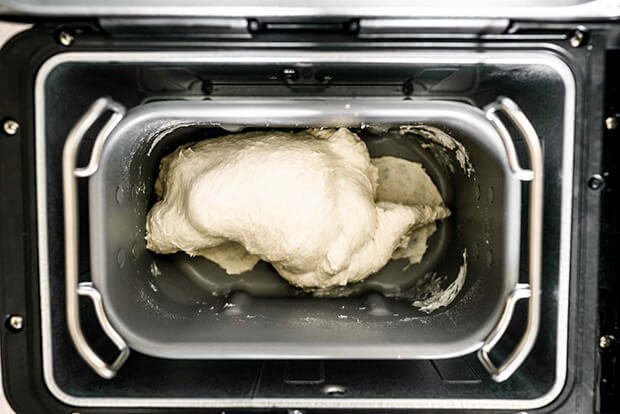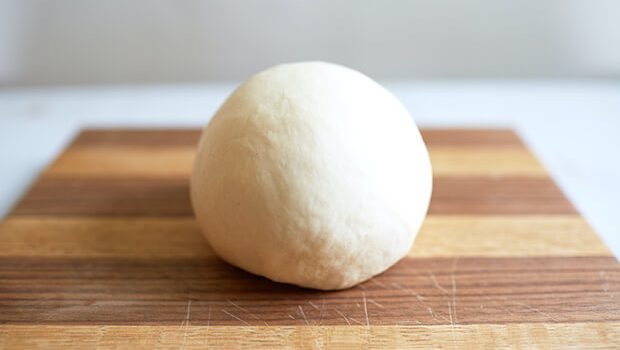QUICK LINKS
Ingredients | Method
Using a bread machine to make sourdough bread
Using your bread machine to make sourdough is a great idea, but it has limitations. Your bread machine is geared to make yeasted bread, often with supermarket pre-mixes. This makes a wonderful loaf of bread! It just won’t work for sourdough and here’s why.
Timing
The preset timing modes of your bread maker are set to the time, temperature and stages of working with yeast to make homemade bread. At best this will 1/4 of the time needed for the sourdough starter to fully work its magic. Yeast is a fast action beast compared to sourdough.
The fast pre-programmed timing of your bread machine will result in an under-proofed sourdough loaf that’s immature, dense and chewy.
Temperature
Making a good loaf of sourdough bread is signed, sealed and delivered in the heat of the oven it’s baked in and most bread machines have a maximum oven temperature of 200°C (392°F). This is great for making a yummy loaf of bread using yeast. Sourdough bread relies on the super high heat of your kitchen oven for its rising boost and a bread machine heats up slowly with the dough inside. They just can’t offer the same initial hit of heat or level of heat.
In comparison, your kitchen oven is likely to reach at least 220°C (428°F). Ideally, it will reach 250°C (482°F), which you can pre-heat before the dough comes anywhere near it. These few extra degrees and the pre-heat ability makes a big difference to the size of the loaf and colour of the crust when making sourdough bread.
Shape
Sourdough is well-loved for being ‘Artisan’. Hand shaped, no two loaves ever the same. Baking your sourdough bread in your oven instead of your bread machine allows you to shape and slash your sourdough bread to look professional.
A strong dough will hold its shape without the need for a bread tin. You will also get a better crust.
Crust colour and crunch
Bread dough releases moisture as it cooks and when baked in a bread machine, it gets trapped inside the tiny environment. Remember a bread machine is hot, but it’s not super and so with all that water in the dough coming out, it gets trapped, making it a sauna inside. The rising bread then sweats throughout the entire bake time.
This is great for creating yeasted loaves that are soft inside with a thin and soft/crunchy crust. Have you ever noticed that the loaves of bread made in your bread machine are always a light golden colour and never glossy? This is why! They were baked in steam and didn’t fully dry out.
In this environment, however, sourdough rises only a little and the crust becomes chewy instead of crunchy. We go out of our way to create steam in sourdough making. I even wet my loaf before baking it. But here’s the difference – the cavity in your kitchen oven is much larger than a bread maker and much hotter. The super-hot air is able to circulate around the bread while it’s baking, even inside a Dutch oven due to surface temperature. This circulation releases the moisture instead of holding on to it, and the water is completely evaporated part-way through the baking process allowing the loaf to dry out on the surface and crisp up for the rest of the bake time.
The result is a loaf that rises, but also hardens properly, giving you great crust colour and crunch!
Using your bread machine to knead sourdough
If you want to use your bread machine to make sourdough bread, use it to mix and knead the dough. Allow your dough to double at room temperature, then shape by hand and bake it in your kitchen oven.
What kneading does to dough and why I use a no-knead method
The hallmark of a good sourdough dough is hydration. The dough stretches and flexes, and has become flexible enough to expand upwards and outwards in a hot oven.
There are two ways to hydrate flour in bread making
1. The fast way is to ‘push’ the water into the flour through kneading
The other…
2. is to let time do this for you by allowing the water to soak into the flour to produce the same result.
I chose to use the soaking (no-knead) method for the BLME Sourdough bread process because:
1. You don’t need a bread machine or dough hook = Anyone can do it
2. The dough requires a good long rest to rise, so you don’t need to be around while it happens = Even busy people can do make sourdough bread
3. There is less room for error = Novices can make a great loaf!
4. It takes 2 minutes so it’s really just so easy = You can do this!
5. The results are almost exactly the same as doing the hard work of kneading 😎
After its long rest, your dough will be well hydrated, giving you a smooth and elastic dough for shaping.
BUT, if you want to knead your dough, you can
Kneading your sourdough dough by hand can be therapeutic. I have done it once or twice. I am not very good at it. Other ways of kneading are to use your bread machine or mix-master with a dough hook.
Kneading the dough for making sourdough will shorten the development time, so there is a great benefit if you just don’t want to wait.
Your ingredients are going to be the same, what will change is the timing and you will need to be on call for your dough as it will double a lot sooner than using the no-knead method. The rise time will vary based on the room temperature. Your dough is ready for shaping when it has doubled in size.

(It looks like an uncooked roast chicken!! 😂)
Ingredients
180g Active sourdough starter (6.4 oz)^
415g Bread Flour* (14.6 oz)
270g Water (9.5 oz)
9g Salt (0.3 oz)
^If you are using BLME Sourdough Flakes, follow these simple steps to growing your own sourdough starter.
Method
1. Place all your ingredients into your bread machine or mix-master bowl.
2. Choose the dough setting and let it run its course. If using a mixmaster & dough hook, it may take up to 10 minutes or more to get a smooth, elastic dough. You can also do this by hand and it will take at least 10 minutes.
3. Place the dough into an oiled bowl, cover with cling wrap and let it sit at room temperature for 3 hours or until doubled. This will vary based on the environment in your kitchen and may take up to 5 hours.
If you are confident in proofing sourdough and want to bake your sourdough loaf after the dough has doubled, read skip the refrigerator and bake your sourdough. Otherwise, continue below.
It’s time to use the refrigerator!
Using your refrigerator to mature proof) your loaf for baking means the second rise slows down – less room for error and you get to choose a more convenient baking time.
SHAPE YOUR DOUGH FOR PROOFING
1. Lightly oil your bench-top and gently tip out your dough. If you made enough for two loaves but made it as one dough, use a dough scraper or firm plastic spatula, cut the dough into two equal halves.
Work gently from here. You want to keep as many air bubbles in your dough as possible.
2. Using wet hands, pinch one side of the dough and stretch it up towards the ceiling, then fold it down and into the centre. Pinch the opposite side and do the same. Repeat with the 4 corners, each time overlapping the previous fold in the centre. This process is like wrapping a present tightly. Pull and stretch 12-14 times until your dough becomes tight.
3. Grab a piece of baking paper and gently place your loaf onto the sheet seam side facing up.
4. Use the baking paper to lower the loaf into a large Tupperware container or oversized bowl.
5. Seal with the Tupperware lid or cling wrap and place into your refrigerator for a minimum of 10 hours, and up to 24 hours.
That’s it until you bake!
Watch this step:
Baking methods
Dutch oven or casserole dish
Pizza stone
Faking it – Baking without a Dutch oven or pizza stone

